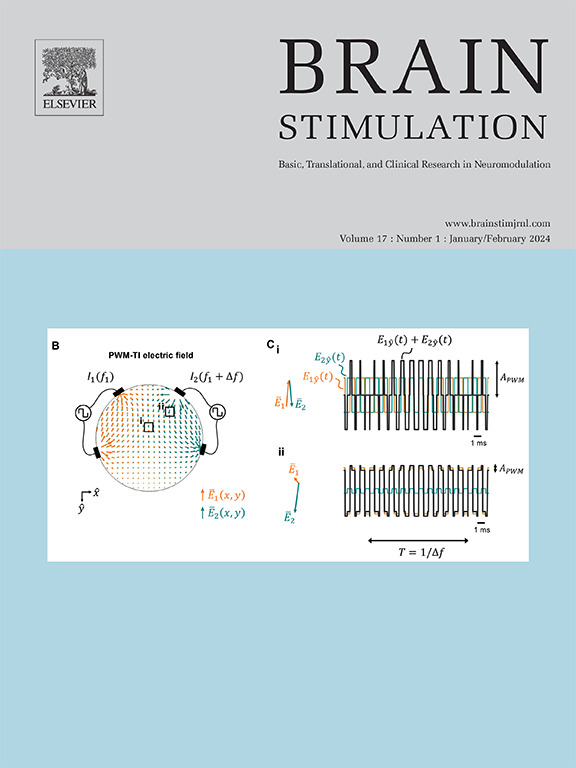Transcranial direct current stimulation and methylphenidate interact to increase cognitive persistence as a core component of metacontrol: Evidence from aperiodic activity analyses
IF 7.6
1区 医学
Q1 CLINICAL NEUROLOGY
引用次数: 0
Abstract
Background
Metacontrol is the ability to optimize the balance between cognitive persistence and flexibility. Recent research points to aperiodic EEG activity as a neurophysiological marker for metacontrol and its modulations. However, the causal link between metacontrol and aperiodic activity is still unclear.
Objective
We provide mechanistic insights into the neurobiological foundations of metacontrol and the means to enhance it. We evaluated the interplay of anodal transcranial direct current stimulation (atDCS) and Methylphenidate (MPH), both of which are known to alter cortical noise, a factor that can be measured by aperiodic exponents derived from EEG data.
Methods
We examined the impact of right inferior frontal (midpoint between electrodes FC4 and F8) 20 min offline atDCS at 2-mA and MPH administration, both separately and combined, on aperiodic EEG activity while healthy adult participants (N = 98) performed a Go/NoGo task. We used the FOOOF (fitting oscillations & one over f) algorithm to examine aperiodic activity.
Results
We obtained an interaction between atDCS stimulation and MPH administration, indicating that atDCS is effective in reducing aperiodic neural activity (i.e., increased aperiodic exponents) when being combined with MPH administration.
Conclusion
Aperiodic neural activity can be modulated through pharmacology-tuned atDCS. atDCS and MPH rely on overlapping neurobiological mechanisms. Metacontrol depending on aperiodic neural activity can be modulated through combined atDCS-MPH stimulation. Hence, atDCS and MPH are suitable tools to achieve an exogenous modulation of metacontrol bias and aperiodic exponents are indices to demonstrate the effectiveness of such tools.
经颅直流电刺激和哌甲酯相互作用增加认知持久性作为元控制的核心组成部分:来自非周期活动分析的证据。
背景:元控制是在认知持久性和灵活性之间优化平衡的能力。最近的研究指出,非周期性脑电图活动是元控制及其调节的神经生理标志。然而,元控制和非周期活动之间的因果关系尚不清楚。目的:对元控制的神经生物学基础和增强元控制的方法提供机制见解。我们评估了阳极经颅直流电刺激(atDCS)和哌醋甲酯(MPH)的相互作用,这两者都可以改变皮层噪声,这是一个可以通过脑电图数据得出的非周期指数来测量的因素。方法:我们研究了在2 ma和MPH给药下20分钟离线dcs的右额下(FC4和F8电极之间的中点)单独或联合对健康成人参与者(N=98)执行Go/NoGo任务时非周期性脑电图活动的影响。我们使用了FOOOF(拟合振荡& 1 / f)算法来检查非周期活动。结果:我们获得了atDCS刺激和MPH给药之间的相互作用,表明当atDCS与MPH联合给药时,atDCS有效地减少非周期神经活动(即增加非周期指数)。结论:非周期神经活动可通过药物调控的atDCS进行调节。atDCS和MPH依赖于重叠的神经生物学机制。依赖于非周期神经活动的元控制可以通过atDCS-MPH联合刺激来调节。因此,atDCS和MPH是实现元控制偏差外源调制的合适工具,非周期指数是证明此类工具有效性的指标。
本文章由计算机程序翻译,如有差异,请以英文原文为准。
求助全文
约1分钟内获得全文
求助全文
来源期刊

Brain Stimulation
医学-临床神经学
CiteScore
13.10
自引率
9.10%
发文量
256
审稿时长
72 days
期刊介绍:
Brain Stimulation publishes on the entire field of brain stimulation, including noninvasive and invasive techniques and technologies that alter brain function through the use of electrical, magnetic, radiowave, or focally targeted pharmacologic stimulation.
Brain Stimulation aims to be the premier journal for publication of original research in the field of neuromodulation. The journal includes: a) Original articles; b) Short Communications; c) Invited and original reviews; d) Technology and methodological perspectives (reviews of new devices, description of new methods, etc.); and e) Letters to the Editor. Special issues of the journal will be considered based on scientific merit.
 求助内容:
求助内容: 应助结果提醒方式:
应助结果提醒方式:


